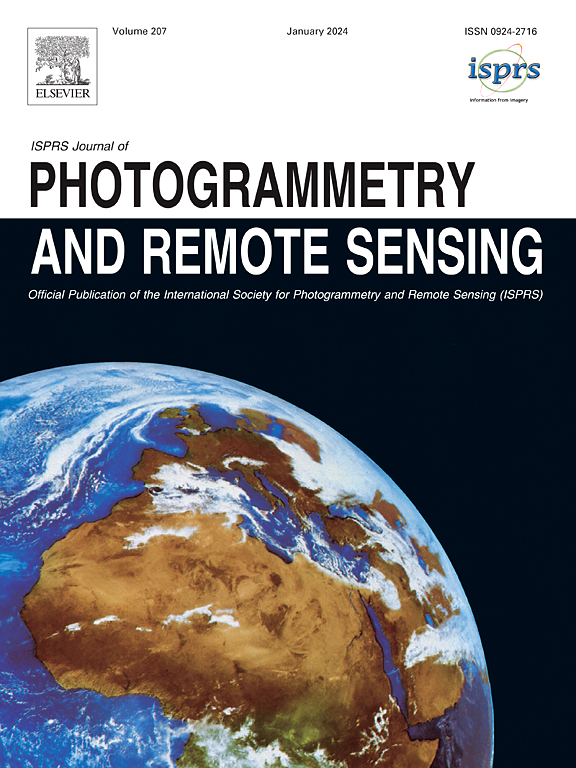一种去除城市区域TLS数据反射噪声的耦合光辐射建模方法
IF 10.6
1区 地球科学
Q1 GEOGRAPHY, PHYSICAL
ISPRS Journal of Photogrammetry and Remote Sensing
Pub Date : 2025-02-01
DOI:10.1016/j.isprsjprs.2024.12.005
引用次数: 0
摘要
点云是一种基本的3D数据类型,在3D重建、自动驾驶和机器人等各种应用中发挥着至关重要的作用。然而,通过测量TLS发射和后向散射激光脉冲的飞行时间产生的点云,往往包含镜面反射表面造成的假点,导致数据质量和保真度下降。介绍了一种消除TLS扫描数据反射噪声的算法。该算法根据光学反射理论,利用反射平面的几何特征和物理特征来识别反射点。对原始激光强度进行辐射校正,然后使用阈值提取反射面。在虚拟点识别阶段,基于镜面反射原理,沿着光传播路径检测虚拟点。此外,采用一种改进的RE-LFSH特征描述符,根据反射对称来评估两点之间的相似性。我们对LFSH特性描述符进行了调整,以保留反射特性,减轻对称架构结构的干扰。在算法中加入Hausdorff特征距离,增强了算法对重影和变形的抵抗能力,从而提高了虚拟点检测的精度。此外,为了克服标注数据集的不足,本文引入了专门为该任务设计的新型基准数据集3DRN。在具有虚拟TLS反射噪声的不同城市环境的3DRN基准数据集上进行的大量实验表明,我们的算法将反射区域中3D点的精度和召回率分别提高了57.03%和31.80%。与现有方法相比,该方法的异常点检测率提高了9.17%,准确率提高了5.65%。您可以通过https://github.com/Tsuiky/3DRN访问3DRN数据集。本文章由计算机程序翻译,如有差异,请以英文原文为准。
A coupled optical–radiometric modeling approach to removing reflection noise in TLS data of urban areas
Point clouds, which are a fundamental type of 3D data, play an essential role in various applications like 3D reconstruction, autonomous driving, and robotics. However, point clouds generated via measuring the time-of-flight of emitted and backscattered laser pulses of TLS, frequently include false points caused by mirror-like reflective surfaces, resulting in degradation of data quality and fidelity. This study introduces an algorithm to eliminate reflection noise from TLS scan data. Our novel algorithm detects reflection planes by utilizing both geometric and physical characteristics to recognize reflection points according to optical reflection theory. Radiometric correction is applied to the raw laser intensity, after which reflective planes are extracted using a threshold. In the virtual points identification phase, these points are detected along the light propagation path, grounded on the specular reflection principle. Moreover, an improved feature descriptor, known as RE-LFSH, is employed to assess the similarity between two points in terms of reflection symmetry. We have adapted the LFSH feature descriptor to retain reflection features, mitigating interference from symmetrical architectural structures. Incorporating the Hausdorff feature distance into the algorithm fortifies its resistance to ghosting and deformations, thereby boosting the accuracy of virtual point detection. Additionally, to overcome the shortage of annotated datasets, a novel benchmark dataset named 3DRN, specifically designed for this task, is introduced. Extensive experiments on the 3DRN benchmark dataset, featuring diverse urban environments with virtual TLS reflection noise, show our algorithm improves precision and recall rates for 3D points in reflective areas by 57.03% and 31.80%, respectively. Our approach improves outlier detection by 9.17% and enhances accuracy by 5.65% compared to leading methods. You can access the 3DRN dataset at https://github.com/Tsuiky/3DRN.
求助全文
通过发布文献求助,成功后即可免费获取论文全文。
去求助
来源期刊

ISPRS Journal of Photogrammetry and Remote Sensing
工程技术-成像科学与照相技术
CiteScore
21.00
自引率
6.30%
发文量
273
审稿时长
40 days
期刊介绍:
The ISPRS Journal of Photogrammetry and Remote Sensing (P&RS) serves as the official journal of the International Society for Photogrammetry and Remote Sensing (ISPRS). It acts as a platform for scientists and professionals worldwide who are involved in various disciplines that utilize photogrammetry, remote sensing, spatial information systems, computer vision, and related fields. The journal aims to facilitate communication and dissemination of advancements in these disciplines, while also acting as a comprehensive source of reference and archive.
P&RS endeavors to publish high-quality, peer-reviewed research papers that are preferably original and have not been published before. These papers can cover scientific/research, technological development, or application/practical aspects. Additionally, the journal welcomes papers that are based on presentations from ISPRS meetings, as long as they are considered significant contributions to the aforementioned fields.
In particular, P&RS encourages the submission of papers that are of broad scientific interest, showcase innovative applications (especially in emerging fields), have an interdisciplinary focus, discuss topics that have received limited attention in P&RS or related journals, or explore new directions in scientific or professional realms. It is preferred that theoretical papers include practical applications, while papers focusing on systems and applications should include a theoretical background.
 求助内容:
求助内容: 应助结果提醒方式:
应助结果提醒方式:


